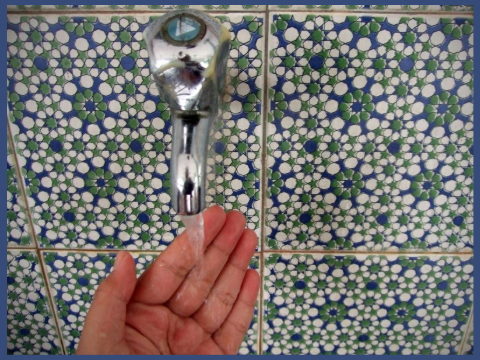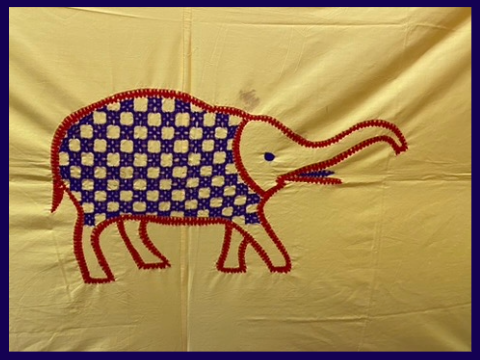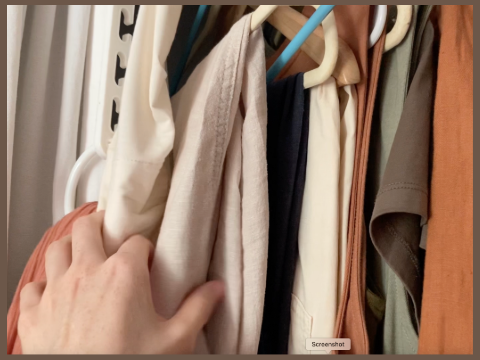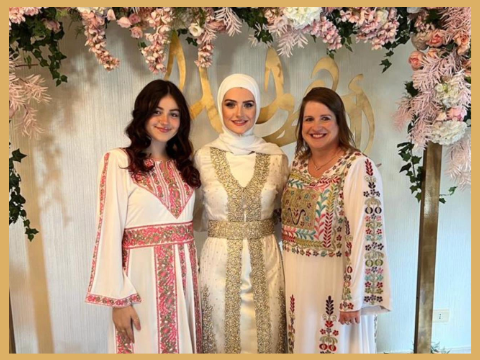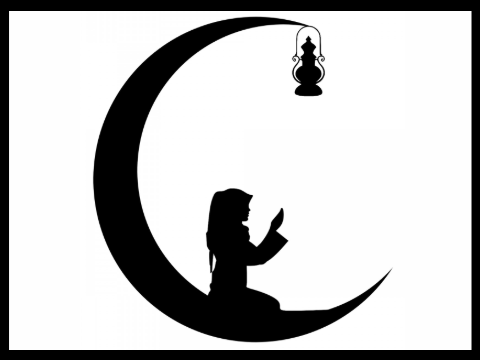
Listen to Chaïmaà Recite her Poem
Listen to Chaïmaà Recite her Story in Prose
Chaïmaà's Poem:
The white sun glow of dawn, so soft, so pure,
Moonlight’s cool breath, eternal and sure,
Awakens within the cyclical flow—
A peace, a stillness only hearts know.
White seeds in earth, turning black to rise,
From birth to death, beneath endless skies.
Gathering the tapestry of creatures as one
Life’s end we meet, wrapped in white,
A shroud for the soul in the afterlife’s light.
Morbid the thought, yet how bright it gleams,
In this truth, I bow, where faith redeems.
A cloth of white beneath me spreads,
Where I pray as it cradles the dead.
Each prayer I offer on this humble sheet,
Is a mirror of the shroud that will wrap my feet.
A symbol of death, yet it calls me near,
To piety, faith, and love sincere.
In every prostration, humility grows,
As I touch the earth, where my body goes.
This cloth, this reminder of where I’ll lie,
Makes me reflect on how and in Allah's hands is why.
In sleep, it covers my dreams in white,
A shroud of peace, a cloak of light.
From fleeting life, I seek reprieve—
In piety’s arms, my soul believes.
This earth, this cloth, so simple, so plain,
Yet through it flows life’s deepest vein.
Before existence, we were bare,
Colorless, as the air we share.
Veins in us and falling leaves are transparently white
We should seek always what is right!
Leaving aside each fight
But bravely fight for the right!
Five times a day, I kneel, I bow,
With a heart unburdened, I make my vow.
The cloth reminds me, death’s embrace,
Is but a step toward Allah’s grace.
Not fear alone, but love, peace, and light,
In white, I meet Him, day and night.
For life’s true essence is free of guise—
In white, we’re born, in white we rise.
In early pregnancy amniotic liquid is white
My wardrobe reflects this sacred sight,
A daily practice, simple, bright.
While waves are tumultuous in the sea,
And the air unsettled when we fly free,
While walking the earth gives steady ground,
In every moment, new trials are found.
But it’s prayer on Earth, the safest place, the safest ground,
That brings me peace, through Allah’s grace.
Spirituality is not an AI’s tale,
Nor divine fashion some fleeting veil.
The clothes I wear, as I bend and pray,
Are from the heart, sincere each day.
In white I trust, till my final breath,
Sincere in life, as I prepare for death.
All creatures return to dust below,
But in white, we’re lifted where rivers flow.
Divine is the garment I wear in prayer,
It brings me peace, beyond compare.
Scientists seek to capture the soul—
When I got invited to the Nobel Prize fair
A futile quest, for it’s Allah’s whole.
The soul, a command from heavens above,
A proof of life, of endless love.
Fast fashion fades, pollutes the air,
While simplicity lingers, beyond compare.
The second thief of earth’s fresh breath,
Stealing water, hastening death.
Let’s slow down, return to white,
For in stillness, we find the light.
Minimalism is the answer we seek,
To modern life’s chaotic streak.
For as I pray, in this cloth so white,
I see the world through a purer light. I seize fight!
I hope we seize fire!
And wear the peace attire!
Chaïmaà's Prose:
The white glow coming from the sun after dawn, and the coolness of the eyes, soothing light of the full moon, bring to mind the cyclical nature of life. In their serene glow, I find peace and the spirituality in which I have grown. White seeds, so pure at first, turn black in the earth, only to grow again. This transformation mirrors the journey of faith; connecting birth to death, reminding me that while the destiny of life is ultimately death, the most fitting garment to wear when meeting heaven is white. How morbid the thought may seem, yet there’s an ironical twist in how bright it feels.
Life’s journey is filled with uncertainty. Waves in the sea are tumultuous as we travel, everything seems to be up in the air when we fly, and yet the ground beneath us when we walk is the most trusted and steady. Every moment can bring a new challenge, but it is through prayer on Earth, the safest ground, that we find peace and security in both calm and trouble. Spirituality, unlike artificial constructs, is a living, breathing truth. It is not an AI—something mechanical or distant. Divine fashion is not a mere symbol; it is no lie. The clothes we wear, and the sincerity in our prayers, by Allah’s command, must come from the heart. When men and women stand to pray, the simplicity and purity of what they wear is a reflection of their souls. This sincerity should remain with us until the day we depart from this world.
I have found peace even in struggles and challenges, especially when I pray on the white cloth beneath me. It symbolizes more than just the act of prayer; it also wraps me like a shroud, resembling the one that will cover me in death. Each time I lay down to sleep, it feels like embarking on a brief journey of death, and through my dreams, I reflect on the nature of life. I want life to expand, not shrink as cloth; to grow, not compress—and this expansion is only achieved through piety and humility in prayer.
This simple white cloth I pray on, wear, and wrap myself in serves as a vivid reminder of death—yet through this, of eternity and the eventual meeting with Allah. As I touch the earth and the cloth, it reminds me of our existence before life, when we were colorless, formless. Allah, the Almighty, brought us to life, and it is through this piece of cloth and my vivid feelings, I come with humility and piety in my heart to meet Him five times a day. In these moments, it is not fear but peace and love that guide me. It is a heavenly beauty that transcends understanding.
The veins in our bodies, like those of the leaves that fall with each season, are largely colorless—just as cells are in their essence. Less, indeed, is more. Allah has brought life to its simplest, purest form. White, being the closest to colorless, represents the beginning of life and the afterlife. It symbolizes piety, peace, and love. My wardrobe is almost entirely white as a way to constantly activate the let go philosophy and that the afterlife matters more. In the grand tapestry of creation and how intricate it is, everything returns to the earth, and eventually, back to Allah.
How divine clothing can be! How it helps us overcome anxieties by reminding us to slow down and embrace eternity through minimalism, using a single pure color. It prompts reflection: can we capture the essence of our souls? Try it! At the Nobel Prize Museum, I was exclusively invited to the "Life Eternal" exhibition 2022 as a teacher and writer. I witnessed top scientists driven mad in their attempts to capture the soul in pictures. They couldn’t. The soul is a miracle—a command from Allah, unseen and eternal. It is full of life, but it is colourless. What a paradox!
This reflection on life, philosophy, and the firm belief in Allah manifests in how I choose to dress. It is not about dressing less, but dressing with purpose. We are dressing less, not economically dressing for less. Such a huge difference! Fast fashion, by contrast, consumes the earth’s resources at an alarming rate. As the second-largest consumer of water and responsible for nearly 10% of global carbon emissions, it threatens the very environment that Allah created. The solution lies in slowing down—returning to simplicity, which can be returning to white. We must reflect and recognize that divinity, simplicity, and mindfulness can coexist with modernity, in ways that are still smart and meaningful.
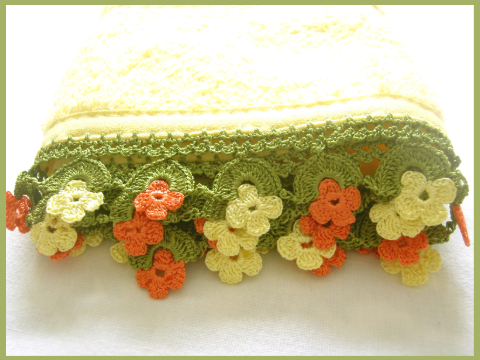
Listen to Derya Tell her Story
Derya's Story:
A must have item for every Anatolian girl and woman in Turkiye is definitely yazma, which is a light headscarf with handmade lacework called oya, knitted around it to wear daily. There are many different names for yazma, in some regions they call it çember, or leçek, or tülbent, or çit, and probably many other names that I still do not know about. The most common one is definitely yazma and oya is pretty much the same word across the country, at least to my knowledge.
I have brought some yazmas that have beautiful handmade oyas with me to the U.S. because as I said it is a must have item for any woman and young girl coming from Turkiye. It is a perfect gift for a young girl who is about to embark on a new journey in her life or simply a great gift to anyone for any reason. Although it might look like a feminine item, a young woman can gift a yazma with beautiful oya to her love as a reminder of her if he is gone somewhere else temporarily. Several oyas find their place inside a young woman’s hope chest. Babies have yazmas with oyas around their cribs. There are folk songs about young girls and women mentioning their oyas and yazmas.
It is such an integral part of our tradition in Turkiye that women and girls of all backgrounds have traditionally created numerous oya patterns across our beautiful Anatolia. Depending on the pattern, there are easier ones to make as well as difficult ones. I myself made a couple oyas for my mom before. It is an entire artwork and the more complicated the oya is, the more skilled its maker must have been. There are machine made oyas too but those are just not as pretty and not cared for so much. It can be made with a crochet needle that has a very thin hook or type of a very small weaving shuttle specifically designed for oya making. Those are the more complicated ones to make but who is afraid of that?
If I am to go to a place where they expect that I wear something traditional, it would definitely be a yazma because I like to show off with its handmade oya. For me, they are the most delicate items that I have in my closet and closest to my heart because each yazma and its handmade oya is a precious piece of clothing with such a long lasting tradition that symbolizes the hard work and dreams of my female ancestors’ heritage of the land I was born in.
My mom has a glass box with beautifully carved and polished dark wood on the edges where she keeps all her yazmas. When someone looks at it, it becomes hard to decide whether to focus on the diligent carving of the wood or the beautiful oyas inside it. It is just beautiful. It even has a key to open it! Apparently, back in the day, it was a tradition for every bride to have a yazma box in her hope chest. Hers was originally her uncle’s wife’s bridal yazma box and she gifted it to my mom when my parents got married. My mom’s uncle’s wife unfortunately passed away but that is the furthest we know about the origins of it.
My mom still keeps this yazma box on top of the wardrobe in her bedroom. She has very carefully folded yazmas with beautiful oyas in so many different colors in it. The yazmas are folded in such a certain way that their oyas would line up on top of each other creating an incredibly beautiful pattern. For me this glass and wood yazma box has always been a magic box. It is not very big but is heavy. My mom would barely open it and any time she did I would get very excited!
Thinking of it takes me back to my childhood bringing back all those good memories. Of course, we were never allowed to touch it because God forbade what if we broke it. I sure would not have wanted to be the kid responsible for such a disaster. Yet, I loved it. Any time I looked at it, I would think of the artisan who carved its wood, of the craftsman who put the glass and the wood together and of the women and the girls who patiently made those oyas. I will never know who they were but their dreams and hard work have stayed with us in our own home in a spiritual way with those oyas. There was and still is a pink yazma which has had my favorite oya up until this day. It has a wider oya than the others and its sugary pink color simply makes it stand out among the other ones, at least for me.
My mom has already designated who will inherit the magic yazma box, it will be my sister. Apparently I will inherit her sewing kit storage box and spice jars, all of which were also made of wood. You might be wondering the history behind those items too but that is a story for another time. :)


